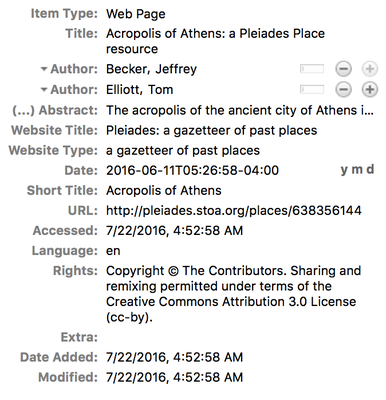How to cite Pleiades
A key goal for Pleiades is to provide a stable reference for ancient places. Pleiades URIs -- combined with contributor attribution and change histories -- provide the basis for stable citation on the web. This document provides human-oriented guidance on construction citations accordingly.
To cite the entire gazetteer as a work in a bibliography, use something like the following (adjusted to reflect the time you accessed the site, and the appropriate bibliographic citation style for your needs):
Roger Bagnall, et al. (eds.), Pleiades: A Gazetteer of Past Places, 2016, <http://pleiades.stoa.org/> [Accessed: July 26, 2016 8:09 pm].
To cite an individual place resource, look for the "suggested citation" heading on the relevant page. For example, on the place resource page for the Acropolis of Athens, you will find:

Selecting the clipboard icon immediately following the citation will copy it to your clipboard so you can paste it into another document.
You can now use Zotero to cite individual place resources (and other pages) in Pleiades. After installing and configuring the Zotero client software of your choice, navigate to the desired page and select the "Save to Zotero" icon in your web browser. Once the save-to-Zotero action is complete, you should find a structured bibliographic record in your Zotero database that looks like this:

Following a suggestion from Daniel Pett (British Museum and Portable Antiquities), we've also added Wikipedia citation codes:
{{cite web |url=http://pleiades.stoa.org/places/69539 |title=Places: 69539 (Noiodounon Diablintum) |author=Galliou, P., R. Talbert, T. Elliott, S. Gillies, J. Åhlfeldt |accessdate=December 7, 2011 3:03 pm |publisher=Pleiades}}
These citation codes also have the helpful copy-to-clipboard icons.
Kudos:
- to Eric Kansa for the example of suggested citations in OpenContext
- to Sean Gillies for thinking of it and making it happen
- to Johan Åhlfeldt for the newly added locations, modern name, and expanded references
- to Seb Chan of Australia's Powerhouse Museum for the Wikipedia citation code recipe
- to the Zotero development team for making Zotero
